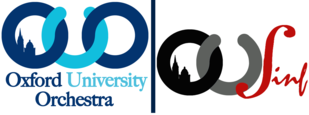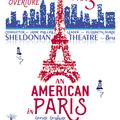Hilary 2017
Saturday 11th February 2017, Sheldonian Theatre
Conducted by Jamie Phillips
Led by Elizabeth Nurse
Copland Symphony No.3
Gershwin An American in Paris
Bernstein Overture from Candide
A review of this concert can be found here:
Oxford University Orchestra Hilary Term Concert - Daily Info | Daily Info
An American far from home in Paris
Guest conductor Jamie Phillips was in Stoke-on-Trent on Friday, conducting Haydn, Mozart and Sibelius, and here he was on a cold Broad Street evening pursuing the peripatetic life of the professional musician by overseeing an all-American programme from the Oxford University Orchestra, with Leonard Bernstein's fingerprints all over it. The latter wrote the first programmed work, the opera Candide in the fifties, and we heard its overture, as usual in this abbreviated form of music replete with the tunes to be heard in the body of the work, and getting us off to a rousing start. The basis for these student programmes is, I take it, to choose colourful works requiring a numerous orchestra with opportunities for the discrete sections to shine, and this rationale was here perfectly fulfilled. The orchestra filed in as a body and received a cheery round of applause by the swelling audience that comprised largely friends and adherents of the players. Mr Phillips announced his style on the podium, bursting with energy and expansive gestures.
The second work before the interval, An American in Paris, is a jazz-tinged symphonic poem by George Gershwin from 1928, and much admired by Bernstein. To those sniffy critics unwilling to allow an upstart composer of jazz and dance works into the hallowed halls of serious music, Gershwin responded: "It's not a Beethoven Symphony, you know... it's a humorous piece... if it pleases symphony audiences as a series of impressions, it succeeds." Inspired by the period when the composer was living and studying in Paris, it evokes the sights and vitality of the 1920s city.
The orchestra now numbered 90-odd, boosted by saxophones, additional percussionists and a set of pseudo-Parisian taxi horns, striving - successfully - to convey a bit of the atmosphere of the Grands Boulevards and the Quartier Saint-Germain des Prés. A jazzy, Broadway musical feel was immediately established in episodes of bustling urban activity punctuated by the stereophonic squabbling of the horns, with brief, hazy visions of peaceful gardens perhaps of the Tuileries and the Jardin du Luxembourg.
Individual players now laid out their credentials. We had a plangent solo from oboist Matt Jackson, swinging his body to the music, some vigorous arpeggios from the double bass section, and in the penultimate bars we heard from the three trombones, with Robert Ham's tuba playing a booming little solo. In the famous Paris by Night section with its violin cadenza that leads into the famous trumpet bluesy passage, a queasy sense swirled round the hall of the homesickness of our American friend far from home in Europe. Soon, though, we are drawn to the hooded lights of a Jazz Club, smoky and sleazy with saxophones.
Aaron Copland's Third Symphony of 1946, distinguished by Leonard Bernstein's definitive recording of 1966, is scored for an equally numerous orchestra, including upright piano, piccolo, cor anglais and cabin-trunkfuls of percussion exotica, played by eight multi-tasking musicians. In the stately beginning, Mr Phillips was adept in his shaping of the opening string lines, based on repetitive quarter notes, in long arcs. He later built the big climaxes with a firm hand, the brass sounding clarion calls that were never harsh. My eye was repeatedly caught by timpanist Ben Varnum standing over his drums, crouching like a tiger about to spring from its jacaranda tree onto a hapless goat tethered to a tree below, crashing down his drumsticks in the crescendos, a picture of intense concentration.
I thought I detected a touch of Shostakovich in Mr Phillips' pointing of the quirky twists in the boisterous 'allegro molto', a big contrast to the 'andantino' with its eloquent, thoughtful string playing what is perhaps the heart of the symphony, giving full expressive force to Copland's darker moments. Here, as earlier in the 1st movement and later in the finale, we heard the expressive flute of Calla Randall. In the latter section, Copland's famous Fanfare for the Common Man anthem is first heard in low-key form from the flutes before ringing out triumphantly from the brass and then being tossed between them and the strings with help from the potent percussion battery.





